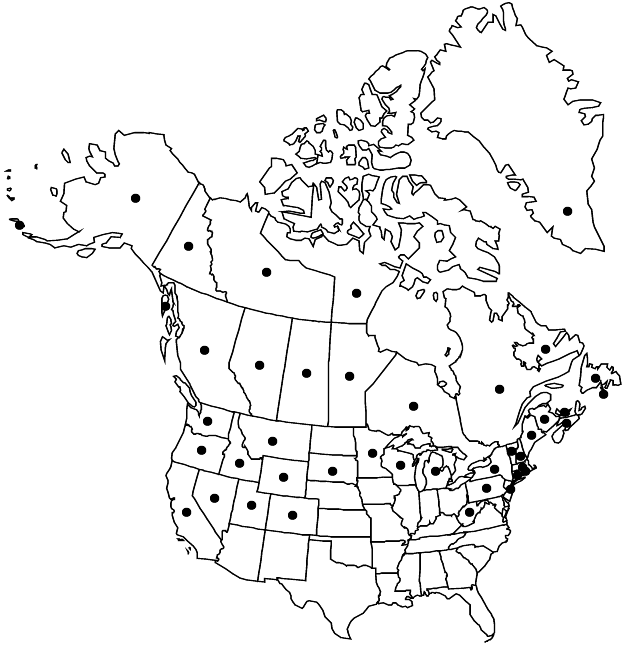Difference between revisions of "Stellaria borealis"
Fl. Boston. ed. 2, 182. 1824.
FNA>Volume Importer |
FNA>Volume Importer |
||
| Line 25: | Line 25: | ||
|distribution=Circumboreal. | |distribution=Circumboreal. | ||
|discussion=<p>Subspecies 2 (2 in the flora).</p><!-- | |discussion=<p>Subspecies 2 (2 in the flora).</p><!-- | ||
| − | --><p>Plants infected with an anther smut, Microbotyrum stellariae (Sowerby) G. Deml & Oberwinkler [Ustilago violacea (Persoon) Roussel, in the broad sense], exhibit flowers with enlarged, reddish anthers. This condition is known in both subspecies, especially in northern areas of the range, but is as yet unknown in Stellaria calycantha, a species previously united with S. borealis by some authors.</p> | + | --><p>Plants infected with an anther smut, Microbotyrum stellariae (Sowerby) G. Deml & Oberwinkler [Ustilago violacea (Persoon) Roussel, in the broad sense], exhibit flowers with enlarged, reddish anthers. This condition is known in both subspecies, especially in northern areas of the range, but is as yet unknown in <i>Stellaria calycantha</i>, a species previously united with <i>S. borealis</i> by some authors.</p> |
|tables= | |tables= | ||
|references={{Treatment/Reference | |references={{Treatment/Reference | ||
| Line 63: | Line 63: | ||
|publication year=1824 | |publication year=1824 | ||
|special status= | |special status= | ||
| − | |source xml=https://jpend@bitbucket.org/aafc-mbb/fna-data-curation.git/src/ | + | |source xml=https://jpend@bitbucket.org/aafc-mbb/fna-data-curation.git/src/8f726806613d60c220dc4493de13607dd3150896/coarse_grained_fna_xml/V5/V5_206.xml |
|subfamily=Caryophyllaceae subfam. Alsinoideae | |subfamily=Caryophyllaceae subfam. Alsinoideae | ||
|genus=Stellaria | |genus=Stellaria | ||
Revision as of 17:37, 18 September 2019
Plants perennial, often matted, rhizomatous. Stems prostrate to ascending or erect, usually diffusely branched, sharply 4-angled, (5–)25–50 cm, glabrous to finely papillate, rarely pubescent. Leaves sessile; blade linear-lanceolate to ovate-lanceolate, rarely elliptic-lanceolate, 1–6 cm × 2–8 mm, base cuneate, margins eciliate or scabrid, sometimes ciliate towards base, apex acute. Inflorescences with flowers solitary, terminal and axillary, or terminal, often copious, very lax, leafy cymes; bracts foliaceous, lanceolate, reduced distally to ca. 2 mm, ± scarious. Pedicels erect or patent, usually reflexed at maturity, 10–40 mm, glabrous. Flowers 3–5 mm; sepals 5, 1–3-veined, lanceolate to ovate, 2–5 mm, margins scarious, apex acute, glabrous; petals 5, rarely absent, white or translucent, 1–3 mm, usually shorter than sepals; stamens 5; styles 3, erect to spreading, 0.9–2 mm. Capsules greenish brown or straw colored, ovoid, 3–7 mm, more than 1–1.5 times as long as broad, exceeding sepals, apex acute, opening by 3 valves; carpophore very short or absent. Seeds 10–20, brown, obovate, 0.7–0.9 mm on longest axis, smooth or slightly rugose. 2n = 52.
Distribution

Circumboreal.
Discussion
Subspecies 2 (2 in the flora).
Plants infected with an anther smut, Microbotyrum stellariae (Sowerby) G. Deml & Oberwinkler [Ustilago violacea (Persoon) Roussel, in the broad sense], exhibit flowers with enlarged, reddish anthers. This condition is known in both subspecies, especially in northern areas of the range, but is as yet unknown in Stellaria calycantha, a species previously united with S. borealis by some authors.
Selected References
Key
| 1 | Sepals ovate to ovate-triangular, with midvein extending to near apex, lateral veins visible only at base; capsules dark brown, opaque, less than 2 times as long as wide, usually 3-4.5(-5) mm; leaf blades elliptic-lanceolate to narrowly elliptic or linear-lanceolate, widest just below middle, usually 2-3 cm; circumboreal | Stellaria borealis subsp. borealis |
| 1 | Sepals narrowly triangular, with 3 prominent, ridged veins extending to near apex; capsule straw colored, translucent, 2 times as long as wide, usually 5-7 mm; leaf blades narrowly lanceolate, widest near base, usually 3-6 cm; w North America | Stellaria borealis subsp. sitchana |